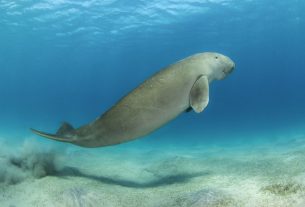[ad_1]
While studying the causes of death in large whales during her PhD, Yara Bernaldo de Quirós became intrigued by the fact that these marine mammals do not suffer from atherosclerosis or other age-related arterial diseases.
A diver herself, she was well aware of how diving affects arterial function. Each dive triggers rapid changes in blood flow and oxygen levels that can strain the arteries over time.
“What if the evolutionary adaptations to diving are actually protecting whales’ arteries from ageing? That could partly explain why these mammals achieve such long lifespans,” said Bernaldo de Quirós, now a biologist at the University of Las Palmas de Gran Canaria in Spain.
Preventing cardiovascular diseases
To explore this idea further, she reached out to Professor Douglas Seals, a leading authority on cardiovascular and arterial ageing at the University of Colorado Boulder in the United States. He immediately saw promise in her hypothesis.
Their collaboration led to a three-year research initiative called Arterial Aging, funded by a grant from the EU’s Marie Skłodowska-Curie Actions programme.
At the core of the project is a compelling idea. Marine mammals – which evolved over millions of years to endure the extreme pressures of deep diving – may have developed natural mechanisms that protect their arteries from ageing.
“
You can improve your diet or exercise more, but you can’t stop ageing.
If confirmed, this discovery could have important implications for preventing cardiovascular disease in humans.
“Cardiovascular diseases are the leading cause of natural death in Europe, and ageing is the primary non-modifiable risk factor. You can improve your diet or exercise more, but you can’t stop ageing,” said Bernaldo de Quirós, who coordinated the EU-funded research effort from June 2021 to May 2024.
Since arterial function inevitably declines with age, finding ways to prevent or slow this process could be key to reducing cardiovascular disease risks.
A new method
To test her hypothesis, Bernaldo de Quirós and a team at the University of Colorado Boulder developed a new method to study how blood affects arteries. They exposed isolated carotid arteries from young and old mice to blood serum from different sources to observe the effects on artery function.
As a first step, the team tested the effects of mouse blood serum.
“After being exposed to the blood serum of an old mouse, young arteries exhibited a decline in function, essentially mimicking the behaviour of old arteries,” said Bernaldo de Quirós.
Interestingly, the reverse was also true. When old arteries were incubated with the blood serum of young mice, their function improved, behaving as if they were younger.
The biologist then conducted the same experiment using human blood serum, which produced similar results.
This was a significant finding. It confirmed that factors present in the circulating milieu – the molecules found in the bloodstream, whether beneficial (e.g. antioxidants) or harmful (e.g. pro-inflammatory compounds) – play an important role in arterial health.
Groundbreaking results
In the final and critical phase of the project, Bernaldo de Quirós tested blood serum from bottlenose dolphins – one of the most accessible and well-studied cetacean species – across a range of ages.
“Unlike what we saw with mouse and human serum, arterial function remained consistently good with bottlenose dolphin serum. Even when arteries from aged mice were incubated with serum from older dolphins, they still maintained healthy function,” she explained.
The results were described as “groundbreaking” by the American Physiological Society. “These findings suggest that the blood of older dolphins retains youth-like, biologically active factors,” said Seals.
New avenues of research
The research carried out by Bernaldo de Quirós and Seals has opened up exciting new perspectives for cardiovascular science.
“A key goal of future research is to identify the specific factors responsible for this effect,” said Seals.
At this stage, the exact reason why dolphin serum has this protective effect remains unknown. Is it due to the presence of specific beneficial molecules that support arterial function? Or could it be the absence of harmful compounds that typically contribute to ageing?
“
These findings suggest that the blood of older dolphins retains youth-like, biologically active factors.
“We aim to conduct a large-scale study of the proteins present in the blood, as well as those produced by the arteries after being incubated with different serums, to identify the mechanisms at play,” said Bernaldo de Quirós.
To advance this research further, Bernaldo de Quirós is teaming up with Professor Laura Muiño Mosquera, an associate professor in paediatric cardiology and cardiogenetics at the University of Ghent in Belgium.
For years, Muiño Mosquera has been conducting research on Marfan syndrome, a condition characterised by premature or accelerated arterial ageing.
“We hope that the combination of both research approaches will help uncover key mechanisms underlying arterial ageing and potential strategies for its prevention,” said Bernaldo de Quirós.
A deeper dive into prevention
With experiments now underway in the Canary Islands and sample collection progressing in Belgium, the researchers are laying the groundwork for a larger international study.
If early results confirm their initial findings, Bernaldo de Quirós and Muiño Mosquera plan to apply for further EU research funding to expand the collaboration.
Their goal is to pinpoint what keeps dolphin arteries young and apply that knowledge to fight cardiovascular disease in humans.
“This is just the beginning,” said Bernaldo de Quirós. “If we can understand the natural mechanisms that protect dolphins from arterial ageing, we might one day develop new ways to safeguard human health, too.”
Research in this article was funded by the EU’s Marie Skłodowska-Curie Actions (MSCA) programme. The views of the interviewees don’t necessarily reflect those of the European Commission. If you liked this article, please consider sharing it on social media.
[ad_2]
Source link



